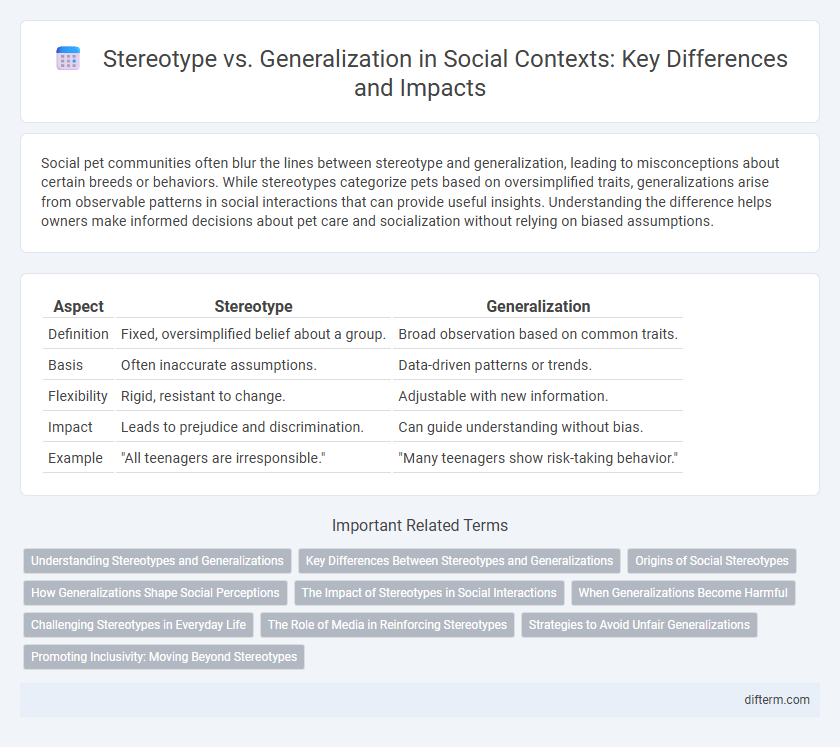Social pet communities often blur the lines between stereotype and generalization, leading to misconceptions about certain breeds or behaviors. While stereotypes categorize pets based on oversimplified traits, generalizations arise from observable patterns in social interactions that can provide useful insights. Understanding the difference helps owners make informed decisions about pet care and socialization without relying on biased assumptions.
Table of Comparison
| Aspect | Stereotype | Generalization |
|---|---|---|
| Definition | Fixed, oversimplified belief about a group. | Broad observation based on common traits. |
| Basis | Often inaccurate assumptions. | Data-driven patterns or trends. |
| Flexibility | Rigid, resistant to change. | Adjustable with new information. |
| Impact | Leads to prejudice and discrimination. | Can guide understanding without bias. |
| Example | "All teenagers are irresponsible." | "Many teenagers show risk-taking behavior." |
Understanding Stereotypes and Generalizations
Stereotypes are oversimplified and fixed ideas about a group, often leading to unfair judgments and discrimination. Generalizations, while also broad statements about groups, can be based on observed patterns but lack the negative rigidity of stereotypes. Understanding the distinction helps promote critical thinking and reduces the risk of prejudice in social interactions.
Key Differences Between Stereotypes and Generalizations
Stereotypes are rigid, oversimplified beliefs about a group that ignore individual variations and often carry negative connotations, while generalizations recognize common traits or behaviors based on observed patterns without implying false absolutes. Stereotypes tend to reinforce prejudices and social biases, whereas generalizations serve as cognitive tools to understand diversity with more flexibility. Understanding these distinctions is crucial for fostering social awareness and reducing discrimination.
Origins of Social Stereotypes
Social stereotypes originate from cognitive shortcuts that help individuals categorize complex social information quickly, often based on limited experiences or cultural narratives. These oversimplified perceptions become entrenched through repeated exposure in media, tradition, and social interactions. Unlike generalizations, which can be provisional and flexible, stereotypes solidify rigid and often inaccurate views about groups.
How Generalizations Shape Social Perceptions
Generalizations simplify complex social information by categorizing groups based on perceived common traits, influencing how individuals interpret behavior and interactions. These mental shortcuts help process social cues quickly but often overlook individual differences, reinforcing biased or incomplete views. Understanding the role of generalizations in shaping social perceptions is crucial for addressing prejudice and fostering more nuanced, empathetic engagement across diverse communities.
The Impact of Stereotypes in Social Interactions
Stereotypes shape social interactions by imposing fixed, oversimplified views on individuals, often leading to misjudgments and reinforcing prejudices. Unlike generalizations, which are broad observations open to exceptions, stereotypes cement biased expectations that hinder authentic communication and empathy. This distorted perception affects behavior, influencing decisions and attitudes in personal and professional relationships.
When Generalizations Become Harmful
Generalizations become harmful when they oversimplify complex social identities, leading to unfair assumptions and prejudice. Stereotypes reinforce these harmful generalizations by attributing fixed attributes to entire groups, limiting individuality and perpetuating discrimination. Recognizing and challenging such generalizations promotes social inclusion and reduces bias.
Challenging Stereotypes in Everyday Life
Challenging stereotypes in everyday life requires recognizing the difference between harmful stereotypes and nuanced generalizations based on evidence. Engaging in open dialogue, seeking diverse perspectives, and questioning assumptions can reduce bias and promote empathy. Consistent efforts to confront stereotypes foster inclusive social environments and encourage critical thinking.
The Role of Media in Reinforcing Stereotypes
Media plays a pivotal role in reinforcing stereotypes by consistently portraying certain groups with oversimplified and fixed traits, which solidifies biased perceptions in society. Repetitive exposure to stereotypical images and narratives in television, films, and social media perpetuates generalizations that ignore individual diversity within groups. These media-driven stereotypes influence public attitudes and behaviors, limiting opportunities for understanding and inclusivity across different social communities.
Strategies to Avoid Unfair Generalizations
Employing active listening and seeking diverse perspectives minimizes the risk of unfair generalizations by fostering empathy and understanding. Encouraging critical thinking and questioning assumptions enhances awareness of stereotype limitations and promotes accurate social interpretations. Implementing education and awareness programs helps dismantle cognitive biases and reinforces respectful communication across social groups.
Promoting Inclusivity: Moving Beyond Stereotypes
Promoting inclusivity requires recognizing the difference between harmful stereotypes and harmless generalizations, as stereotypes often lead to prejudiced assumptions that limit individual identity. Inclusive environments celebrate diversity by challenging fixed notions and encouraging open-minded understanding of varied cultural, social, and personal experiences. Educators, leaders, and communities play a crucial role in fostering empathy and reducing bias, creating spaces where every individual feels valued beyond simplistic categorizations.
stereotype vs generalization Infographic

 difterm.com
difterm.com